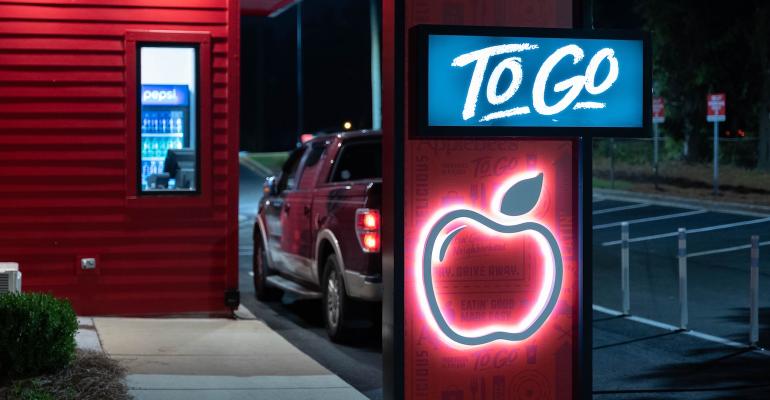Applebee’s Neighborhood Grill + Bar continues to test its pickup windows and parent Dine Brands Global Inc. will decide by next year what the future holds beyond the current 10 convenience-oriented options, says John Cywinski, president of the casual-dining brand.
 “By the time we get to the summer,” Cywinski said in an interview last week after Dine Brand’s released third-quarter earnings, “I'll have a clear business case. I'm looking at three variables: guest satisfaction, team member satisfaction (including operational benefits) and then financial return on that investment.”
“By the time we get to the summer,” Cywinski said in an interview last week after Dine Brand’s released third-quarter earnings, “I'll have a clear business case. I'm looking at three variables: guest satisfaction, team member satisfaction (including operational benefits) and then financial return on that investment.”
The first Applebee’s pickup window, which is for online orders and delivery drivers, opened earlier this year. Cywinski said the investment is between $100,000 and $150,000, depending on the location.
“The early indications are very positive,” Cywinski said. “Guests love it. It just makes it easy. They order online. They come and they pick it up. And they don't have to get out of their car.” Team members also don’t have to leave the building, which is a safety and climate concern, he added.
“It also allows you to stay open a little later at night perhaps because you're moving that that food through a window as opposed to walking it out to a parking lot,” he added.
By the middle of next year, Cywinski expects the brand to have 15 to 20 of the pickup windows operating among the brand’s 1,571 locations.=
“We haven't gone through a feasibility study to gauge how many of our 1,571 restaurants can actually retrofit a drive-thru pickup window should they want to be part of the evolution,” he said. “But we think it's a meaningful incremental business opportunity and our franchisees believe in it as well.”
In the third quarter, a little more than 24% of Applebee’s sales are off-premises, which has been holding steady in the past few reporting periods.
“We are beginning to build new restaurants,” Cywinski said. “That building looks a little different.” He added: “Perhaps the next evolution and all new buildings — all new prototypes — will incorporate a footprint conducive to having more than 20% of the business off-premises.”
Cywinski said he expected the level of off-premises sales to continue, adding that systemwide it has grown into a $1.1 billion business annually. Cywinski noted that off-premises has grown from about 1% in the early 2000s, when the brand introduced curbside pickup, and it is about double the rate before the pandemic was declared in March 2020.
The Applebee’s brand is again 100% franchised after the third-quarter sale of 69 units in South Carolina and North Carolina, which the company had held since 2018. Average annual unit volumes have also grown, he said, rising from about $2.2 million to more than $2.7 million currently.
“We have some momentum,” Cywinski said. “I've always found momentum to be elusive; you've got to nurture it and you've got to protect it and you've got to understand why you have it.”
He said his role is “nurturing momentum, maintaining whatever the guests find appealing about our brand and maintaining that awareness and frequency of visitation.” Franchisees have bought into that vision and take a long view of their market share, Cywinski said.
For the third quarter ended Sept. 30, Dine Brands’ net income slipped to $20.9 million, or $1.32 a share, from $23.1 million, or $1.33 a share, in the same period a year ago. Dine Brands’ revenues for the third quarter were $233.2 million, up from $228.7 million in the prior-year period.
Applebee’s same-store sales increased 3.8% in the third quarter. Off-premises sales accounted for 24.2% of sales mix, representing per restaurant average weekly sales of about $12,800. IHOP’s same-store sales increased 1.9% in the third quarter. Off-premises sales accounted for 20.4% of sales mix, representing per restaurant average weekly sales of about $7,700.
Dine Brands Global has about 3,400 full-service restaurants in 16 countries.
Contact Ron Ruggless at [email protected]
Follow him on Twitter: @RonRuggless





